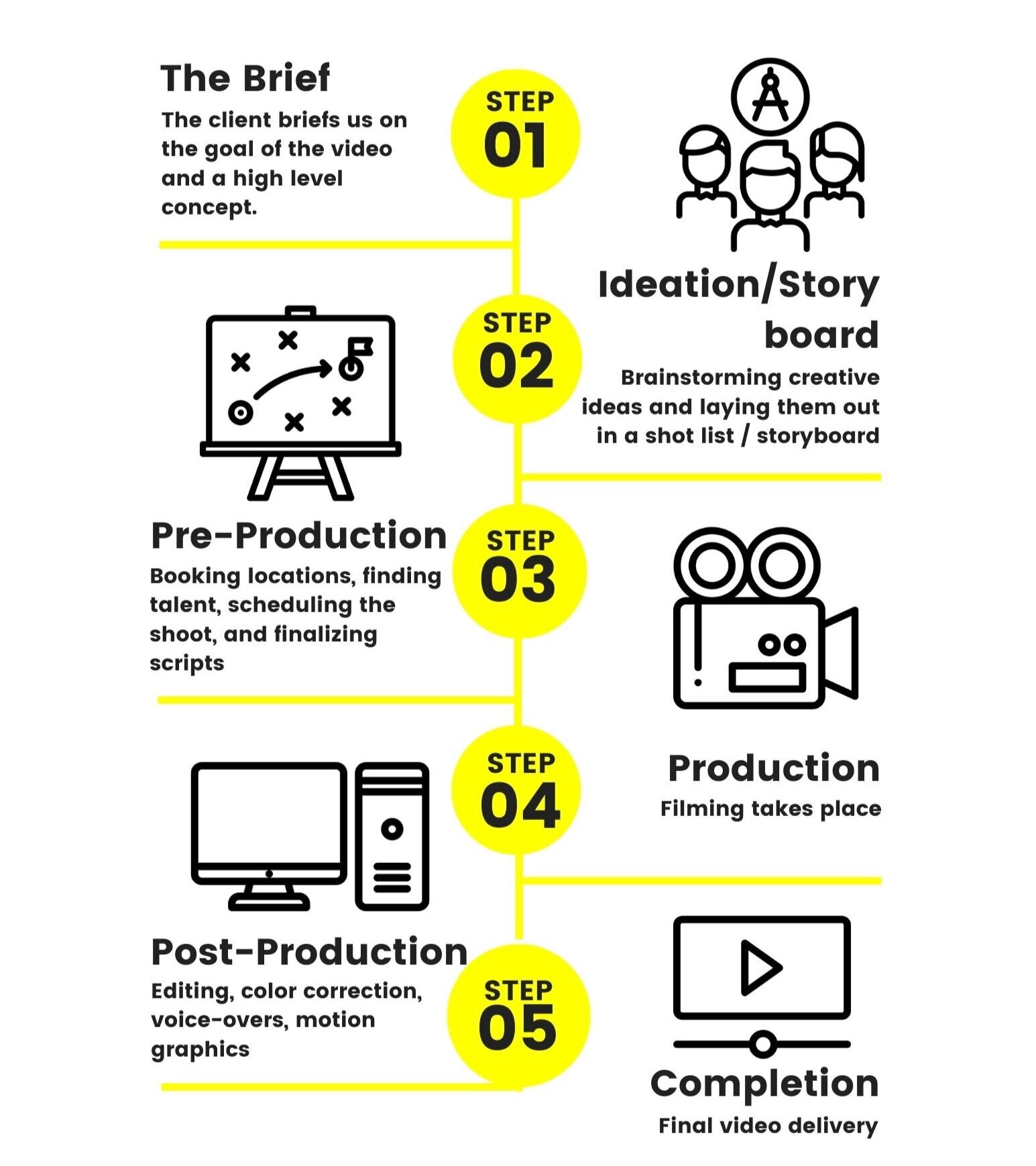2024 Video Marketing Guide
Prepare your team for your next video production with this guide.
Advocate for video more effectively and get the most out of your next video investment.
Video marketing can feel like an entirely new realm for those who have not worked with video before. There is unfamiliar terminology and it’s a medium that can require large teams on-set to produce. Although YouTube has been around for 16 years now, many organizations are still trying to understand how effective video can be and if they are missing out. In the guide below, you will find powerful statistics that demonstrate video is here to stay along with useful tips and tools for getting the most out of your next video production.
Video Marketing Guide Topics:
78% of people watch online videos every week*
Viewers retain 95% of the intended message when they watch it in a video compared to 10% in text*
A website is 53x more likely to reach the front page of Google if it includes video*
84% of video marketers say video has helped them generate leads*
*
https://blog.hubspot.com/marketing/
https://www.insivia.com/50-must-know-stats-about-video-animation-marketing-2013/
https://www.wyzowl.com/video-marketing-statistics/
It's a question many marketers have asked, especially when they have to justify video production costs to their leadership. In this guide, we will examine how almost every metric for tracking the value of marketing videos, makes a strong case for the investment.
We have passed a turning point where thanks to high-speed internet and lower production costs, video has become an effective marketing tool for businesses of all sizes. Not convinced? See what consumers and marketers have to say....
84% of people say that they’ve been convinced to buy a product or service by watching a brand’s video (wyzowl)

The number of businesses using video as a marketing tool has increased by 41% since 2016
Consumer Trends Towards Video
High-Speed Internet and Social Media Paves the Path for Video
Since the founding of YouTube in 2005, consumer video consumption has skyrocketed. Online video popularity started on personal computers, but quickly expanded to mobile devices. In 2013, Instagram added video capability to their mobile app after the success of apps like Vine.
Widespread adoption of video across the internet and on social media apps was made possible because of high-speed internet. Without high-speed internet, there wouldn’t have been enough bandwidth to stream video content to millions of devices. Looking forward, by 2022, online videos will make up more than 82% of all consumer internet traffic according to Cisco.
That's 15 times higher than it was in 2017.
Video is a Megatrend
We are currently riding a wave of e-commerce and digital content adoption that continues to be fueled by new generations. Generation Z makes up 40% of all consumers. They are the first generation to grow up with the internet from the day they were born onwards. They're more likely than any other generation to make buying decisions online.
Are you reaching them with your current sales and marketing strategies?
In February of 2017, Mark Zuckerberg stated "I see video as a megatrend". This is no surprise to us now in 2022 when our Facebook feeds are now filled primarily with video content.
We can also see that video has become a powerhouse by looking at the growth of product-based searches on YouTube, making it the second-largest search engine in the world. According to Google statistics, watch time for youtube videos on "which product to buy" search queries has doubled YOY.
Can customers find you on YouTube?

How to Get the Most Out of Your Video investment
Video productions require a significant investment from marketing budgets. Getting the most out of your investment requires investing your time upfront in the process to prevent cost overruns later in the project.
Below are a few tips on how to get the most out of your next video production project.
Focus on Desired Results
It's easy to fall into the trap of wanting your video to do everything for your business. Increase leads, sales, engagement, brand awareness, etc.
Multiple mixed goals dilute the message of your video which produces poor results. Pick one primary goal and focus on that. Your video's story, script, and messaging will all be designed around this goal which is why it's important to be very clear about what you are aiming to achieve.
Know Your Audience
It's vital to understand your audience for corporate videos. You need to understand what they like and how they think in order to produce a video that they will connect with.
Spend time analyzing your current customers and create personas that can be used in the video script and story development.
Designate Decision Makers
Video productions can have cost overruns when there are frequent changes to the video scope or extra revisions during the editing process. These changes are typically driven by indecision and the lack of a clear decision-maker who has the authority to make final creative decisions.
Designate someone internally as your Creative Director and/or Project Manager who aligns internal teams and has decision-making control.
Invest Time in Pre-Production and Ideation
The upfront planning during pre-production is key to a successful video marketing campaign. Video shoots are complex with large collaborative teams that require a clear direction to beautiful and captivating videos.
Spending time upfront to create a clear plan pays dividends on-set during filming.

Powerful Video Ad Metrics
Measuring ROI
Measuring the return on investment (ROI) of video production is crucial for businesses to understand the impact their videos have on their bottom line. Video ROI can be measured by tracking several key metrics, including viewership, engagement, lead generation, and sales.
Viewership metrics, such as views, watch time, and completion rate, provide insight into the reach and popularity of the video. Engagement metrics, such as likes, comments, and shares, indicate the level of interest and connection the audience has with the content. Lead generation metrics, such as form submissions and email captures, track the effectiveness of the video in attracting and converting potential customers. Finally, sales metrics, such as revenue and conversion rate, measure the direct impact the video has on the business's bottom line.
By tracking these key metrics, businesses can not only measure the ROI of their video production but also gain valuable insights into their audience and the effectiveness of their marketing strategies. This information can be used to optimize future video production and ensure maximum return on investment.
Unlock Retargeting
The following section covers some concepts that may be considered advanced to marketers with no online advertising experience. Retargeting is a type of advertising strategy where you display ads to people who have interacted with your ads or content previously.
Compared to text or image-based ads, video can provide additional metrics that are powerful for retargeting that lower your cost of acquisition. The primary metric that allows you to do so is watch time. By creating retargeting campaigns that target consumers who have watched 15%, 25%, 50%, or even 95% of your video, you can optimize your ad spend towards the consumers who will most likely convert. Consumers with a low watch time can be grouped into a campaign with lower ad spend. Ultimately, leads with a high chance of converting receive the highest % of your ad dollars while also costing less to convert.
If your videos are displayed on YouTube, you can also retarget additional videos, text-based ads, and image-based ads towards viewers who have watched your content. Google's powerful Ad platform allows you to link your YouTube account with your Ad account for very specific audience targeting. If a consumer found you on YouTube, you can continue to market to them on multiple platforms and through multiple mediums. Your video content is essentially acting as a lead qualifier which will help reduce your lead conversion costs in follow-on campaigns.
Social Media Retargeting
Below are some of the metrics you can use for reporting or retargeting on Facebook and Google. The goal is to allocate ad spend towards consumers who have pre-qualified themselves by watching your content previously.
Facebook Retargeting
3 seconds or more
10 seconds or more
15 seconds-plus or completed the video (ThruPlay)
25% or more
50% or more
75% or more
95% or more
Google Retargeting
Viewed any video from a channel
Viewed certain videos
Viewed any video (as an ad) from a channel
Viewed certain videos (as ads)Subscribed to a channel
Visited a channel homepage
Liked any video from a channel
Added any video from a channel to a playlist
Shared any video from a channel

It's been 16 years since YouTube's website launched to the public in May 2005. Are you on YouTube?
Video Best Practices For Ads
The following are best practices for videos you intend on using in social media ads. The primary takeaways are to make it short, get to the point, and keep it authentic.
Capture attention quickly and Put the most compelling part of your video at the very beginning to grab interest.
Settle on 15 sec or 30-sec videos. Consumer attention spans have dropped. 66% of ads are 30 seconds and 32% are 15 seconds.
Be authentic and show a personal transparent side to your brand
Feature branding early in your videos to ensure brand association and awareness
Design videos for sound-off viewing as a majority of video views today are on mobile with the sound off

